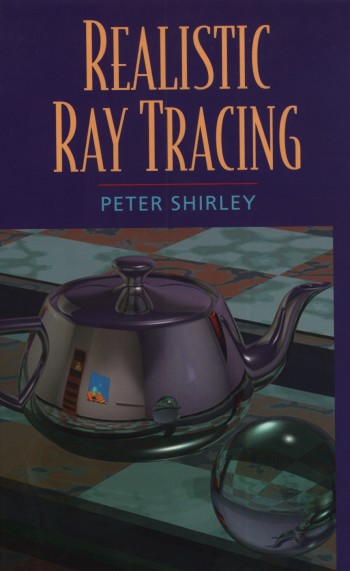|
Realistic
Ray Tracing
Author:
Peter Shirley
Publisher: A.K. Peters
ISBN: 1-56881-110-1
Purchasing: [Amazon.Com]
- RRP US$35
Reviewed: 4th August 2002
Front
Cover Shot:

Overview
Ray
tracing is not new technology - several papers
were published on the topic as early as 1980.
However, with recent advances in
processor/computing power it is almost possible to
do reasonable quality ray-tracing in real time
(compared with several hours per-frame).
For
those who are completely blank, ray tracing is a
method for accurately modeling the behavior of
light in a 3D scene. Light travels in straight
lines, hence the "ray" part, and
"tracing" to model how it reflects,
refracts and shades the surfaces it meets. Up
until recently it has been almost exclusively a
technique employed by only the most advanced 3D
imaging/rendering programs (such as Lightwave and
3DSMax). Now it is regularly used by games to
generate light maps for 3D worlds.
Anisotropic
Specular Bidirectional Reflectance Distribution
Function's
First
off, this book is not for the feint-hearted, it is
essentially an academic/university level text.
It's heavy on the language (The title above is a
section towards the end of the book, and yes, I
did choose the most complicated one I could find!)
and even heavier on the mathematics.
You
don't necessarily need to be a genius, or even at
university level; where appropriate a good, solid
explanation is provided. The first main chapter of
the book covers all the basic math functions -
vectors, matrices and color operations. Anyone
with a decent understanding of mathematics
(pre-university level) will be able to work with
this book. The math later on in the book gets
incredibly complicated, but thankfully there is
always a summary equation/example such that you
can still do the practical side of things even if
you don't fully understand how/why you get there.
Structure
The
book itself is very small in comparison to most
computer/technical manuals. Weighing in at a mere
165 pages where each is (roughly) A5 size makes it
quite an expensive book given the physical
size/length of the text.
However,
there are very few long code-listings and large
images so almost all the space is used up on
relevant content. Having read through it, it
definitely does not come across as being a
small/short book.
There
are three parts making up this text, starting with
a basic (and complete) ray tracer, then adding
some "bells and whistles" before
finishing up with a discussion of the most
advanced topics. This is a very clear and useful
way to structure this book - once you've completed
part 1 you will have a fully functional ray-tracer
(albeit very simple). You can then read through
the advanced topics and "plug them in"
to your existing engine, whilst it would be best
if you implemented all of the advanced features,
it would be perfectly reasonable to
pick-and-choose from the advanced topics.
Just
a book
Unlike
the vast majority of other computer/technical
manuals reviewed on this site there is no bundled
CD included with this book. This isn't as much of
a bad thing as it sounds; all of the
"code" presented in the text is written
as psuedo code and math in math, regardless of
language. Therefore from reading this book you can
write your engine in any language without any
hassle of mentally converting any code presented.
It would probably work best if you used one of the
newer object orientated languages - .Net language,
Java, C++ and VB6 (to a lesser extent).
Brief
discussion of refraction
The
book does a very good job of covering all the
bases, and where it doesn't go the full distance
it has an extensive references list for further
reading. However, I was mildly disappointed with
the rather brief coverage of refraction.
Refraction
is where a ray of light will change direction when
passing through a semi-transparent/different
density object (in simple terms). For example, it
would be the reason why the image appears
distorted through a glass-ball/statue.
The
math behind refraction is covered - and the
eventual formula would be useful if you
implemented refraction; but it's not got as good
coverage as some other areas in the book.
In
Conclusion
If
you can handle the complexity of the ideas in this
book, then you'll find it a very useful reference
for ray-tracing. Even the simple engine (maybe
with added soft shadows) would prove to be very
useful when generating a light map for
real-time/multimedia 3D worlds.
| Good
Things |
Bad
Things |
| •
A very useful text covering all the major
areas. |
•
Very heavy on mathematics - you need to be
a competent mathematician to get anywhere. |
| •
Not (programming) language specific. |
•
No CD included - and no solid sample code
to copy down/test. |
| •
Good introductory section laying the
groundwork. |
|
| •
Good reference list for those who want to
read-around the subject further. |
|
| •
Peter Shirley obviously knows a lot about
ray-tracing, so definitely a trustable
source. |
|
|

